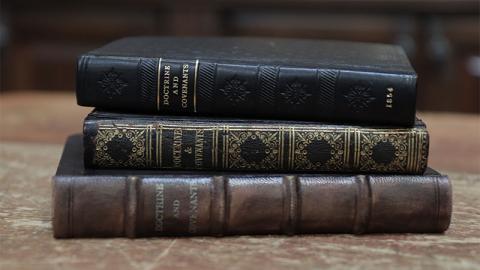You are here
Book of Mormon Central is in the process of migrating to our new Scripture Central website.
We ask for your patience during this transition. Over the coming weeks, all pages of bookofmormoncentral.org will be redirected to their corresponding page on scripturecentral.org, resulting in minimal disruption.

D&C 133–134
New from BMC
Watch videos from Gospel scholars and teachers to learn more about these sections of the Doctrine and Covenants. Book of Mormon Central produces weekly videos from Tyler Griffin, Taylor Halverson, John Hilton III, Anthony Sweat, Casey Griffiths, Stephanie Dibb Sorensen and Marianna Richardson. Read commentaries and other resources from KnoWhys, Steven C. Harper, Casey Griffiths, and Susan Easton Black.
Videos
Doctrine and Covenants 133
Doctrine and Covenants 134
Daily Reading Plan
Structure your personal scripture study by following a 15-minute, day-by-day plan. Each day's assignment includes the required scripture passages from the Come, Follow Me curriculum, as well as suggestions for additional resources to bring context and understanding to your study. For the best experience, use our Reading Plan in the free ScripturePlus app! You can track your progress and have access to the best resources.
Monday
- Commentary: Section 133 Context, Steven C. Harper
- Scripture: D&C 133:1–15
- Commentary: Casey Paul Griffiths, Doctrine and Covenants Minute, Doctrine and Covenants 133:1–6.
- Commentary: Casey Paul Griffiths, Doctrine and Covenants Minute, Doctrine and Covenants 133:7–16.
Tuesday
- Scripture: D&C 133:16–24
- Commentary: Casey Paul Griffiths, Doctrine and Covenants Minute, Doctrine and Covenants 133:17–35.
- Video: (casey)
Wednesday
- Scripture: D&C 133:25–40
- Commentary: Casey Paul Griffiths, Doctrine and Covenants Minute, Doctrine and Covenants 133:36–40.
-
Quote: Water is the universal element, and it is the symbol of life. Jesus used it to describe a personal testimony of his divinity. Pure water will also be one of the secrets of the earth’s regeneration in preparation for its millennium. The Lord said, “And in the barren . . . ground shall no longer be a thirsty land” (D&C 133:29). However, the richest treasures do not come from water breaking forth in the wastelands of the desert.
The greatest enrichment comes when we acquire a personal testimony of the divine mission of the Savior of the world and a firm determination to make our lives productive in godliness. Dr. Henry C. Link once said that nothing puts so much order into human life as to live by a good set of sound principles. And the soundest principles are the principles of the gospel of Jesus Christ. Water is also a symbol of cleanliness, and Jesus indicated that after cleansing ourselves with the soap and water of repentance, we should be baptized and have our sins washed away by his atoning sacrifice.
Sterling W. Sill, “We Would See Jesus,” April 1968 General Conference. -
Quote: The work of the Lord is accomplished as His gospel is “preached unto every nation, and kindred, and tongue, and people” (D&C 133:37) and as His everlasting covenant is established through the ordinances of the temple.Just as the Savior invited Mary and Martha of New Testament times (Luke 10:38–42) to participate in His work, women of this dispensation have an official commission to participate in the Lord’s work. From the earliest days of the Restoration, women were active in helping build up the Church by supporting missionary efforts, contributing to the construction of temples, and establishing communities where the Saints could worship together. The organization of Relief Society in 1842 mobilized the collective power of the women and their specific assignments to build the Lord’s kingdom, just as the organization of priesthood quorums gave men specific responsibilities.
Julie B. Beck, “Fulfilling the Purpose of Relief Society,” October 2008 General Conference. -
Quote: If one should read the Doctrine and Covenants through and tabulate the various subjects that the Lord revealed information on, he would find that missionary work holds a dominant place. In my study of modern revelation, I have found that there is no subject that the Lord revealed more about, that he talked on more times and in more ways than the missionary assignment. In fact, the gospel of the kingdom must be taken unto every nation, and kindred, and tongue, and people preparatory to the coming of the Lord; and after this great assignment has been successfully completed, according to the words of Jesus Christ, our Lord and Savior, “. . . then shall the end come” (Matt. 24:14; D&C 133:37).
Not only must the gospel be taken “to every nation, and kindred, and tongue, and people” here in mortality, but it must also be preached to all of our departed ancestors in the spirit world. A great missionary campaign must go forward until all who have died without the law of the gospel will have the opportunity to accept or reject it. Temple work will not be completely effective without missionary work. In fact, the people in the spirit world have to learn the various gospel truths, receive the gospel plan of salvation, repent of their sins, and prepare themselves to receive the temple ordinances which have been performed for them vicariously before that great work reaches a fulfillment and gives to the people the blessings that they should receive.
Milton R. Hunter, “The Missionary Assignment,” October 1951 General Conference.
Thursday
- Scripture: D&C 133:41–56
- Commentary: Casey Paul Griffiths, Doctrine and Covenants Minute, Doctrine and Covenants 133:41–51.
- Commentary: Casey Paul Griffiths, Doctrine and Covenants Minute, Doctrine and Covenants 133:52–56.
-
Quote: In addition to the consequences of scourging, how Christ’s lifeblood had already flowed in Gethsemane! Remember, he suffered “both body and spirit” (D&C 19:18). Declared King Benjamin, Christ would suffer “even more than man can suffer, except it be unto death; for behold, blood cometh from every pore, so great shall be his anguish” (Mosiah 3:7).
Having bled at every pore, how red His raiment must have been in Gethsemane, how crimson that cloak!
No wonder, when Christ comes in power and glory, that He will come in reminding red attire (D&C 133:48), signifying not only the winepress of wrath, but also to bring to our remembrance how He suffered for each of us in Gethsemane and on Calvary!
Neal A. Maxwell, “Overcome… Even As I Also Overcame,” April 1987 General Conference. -
Quote: Another fundamental scripture describes Jesus’ having trodden the winepress of the “fierceness of the wrath of Almighty God” (D&C 88:106; D&C 76:107; D&C 133:50). Others can and should encourage, commend, pray, and comfort, but the lifting and carrying of our individual crosses remains ours to do. Given the “fierceness” Christ endured for us, we cannot expect a discipleship of unruffled easiness. As we seek forgiveness, for example, repentance can be a rough-hewn regimen to bear. By the way, let us not, as some do, mistake the chips we have placed on our own shoulders for crosses!
Neal A. Maxwell, “Plow in Hope,” April 2001 General Conference.
Friday
- Scripture: D&C 133:57–74
- Commentary: Casey Paul Griffiths, Doctrine and Covenants Minute, Doctrine and Covenants 133:57–74.
-
Quote: In the 133rd section of the Doctrine and Covenants, the Lord defined “the fulness of his gospel” as “his everlasting covenant” (D&C 133:57).
By accepting membership in the Church, through baptism and the laying on of hands for the gift of the Holy Ghost, a person enters into a covenant with the Lord to obey and live by all the requirements of the gospel. The Lord’s promise, conditioned upon such obedience, is the gift of eternal life.
Marion G. Romney, “Caring for the Poor—A Covenantal Obligation,” October 1978 General Conference. -
Quote: I would like to speak about God’s realm of light in contrast to the dark realm of Satan. Those who follow Satan will be cast into outer darkness, “where there is weeping, and wailing, and gnashing of teeth” (D&C 133:73). How terrible to live in such a place of darkness and cold. It is entirely different from what we usually think of as “burning in hell.” That burning is the lasting regret one feels who has chosen the darkness of Satan in preference to the light of Christ.
Through modern revelation we have been taught that “the glory of God is intelligence, or, in other words, light and truth.” Such light and truth forsake the evil one (D&C 93:36–37).We have been advised that if our eye be single to the glory of God, our whole body shall be filled with light, and there shall be no darkness in us, for a body which is filled with God’s light will be able to comprehend all things (D&C 88:67).
We further read that the light of God “shineth in darkness, and the darkness comprehendeth it not; nevertheless, the day shall come when you shall comprehend even God, being quickened in him and by him.
Theodore M. Burton, “Light and Truth,” April 1981 General Conference.
Saturday
- Commentary: Section 134 Context, Steven C. Harper
- Scripture: D&C 134:1–6
- Commentary: Casey Paul Griffiths, Doctrine and Covenants Minute, Doctrine and Covenants 134:1–4.
- Commentary: Casey Paul Griffiths, Doctrine and Covenants Minute, Doctrine and Covenants 134:3–8.
Sunday
- Scripture: D&C 134:7–12
- Commentary: Casey Paul Griffiths, Doctrine and Covenants Minute, Doctrine and Covenants 134:9–10.
- Commentary: Casey Paul Griffiths, Doctrine and Covenants Minute, Doctrine and Covenants 134:11–12.
- Video: (Casey)
Bibliography
Doctrine and Covenants 133
Steven C. Harper, “Section 133,” Doctrine and Covenants Contexts (Springville, UT: Book of Mormon Central, 2021), 357–359.
Susan Easton Black, “An Appendix - Insight Into D&C 133,” Restoration Voices Volume 2: Insights and Stories of the Doctrine and Covenants (Springville, UT: Book of Mormon Central, 2021).
Matthew C. Godfrey, “William McLellin's Five Questions,” Revelations in Context: The Stories Behind the Sections of the Doctrine and Covenants. Salt Lake City, UT: The Church of Jesus Christ of Latter-day Saints, 2016.
“Endowment of Power,” Church History Topics.
“Solemn Assemblies,” Church History Topics.
Robert J. Matthews, “The Restoration of All Things: What the Doctrine and Covenants Says,” in Sperry Symposium Classics: The Doctrine and Covenants, ed. Craig K. Manscill (Provo, UT: Religious Studies Center, Brigham Young University, 2004), 68–91.
R. Lanier Britsch, “By All Means: The Boldness of the Mormon Missionary Enterprise,” in Go Ye into All the World: The Growth & Development of Mormon Missionary Work, ed. Reid L. Nielson and Fred E. Woods (Provo, UT: Religious Studies Center, 2012), 1–20.
D&C 133:4
Sharon Anderson, “Latter-day Gathering,” in The Glory of the Son (Orem, UT: Time-Lines Etc., 2019), 58.
D&C 133:16
Sharon Anderson, “Near a Salty Sea,” in The Glory of the Son (Orem, UT: Time-Lines Etc., 2019), 68.
D&C 133:25
Sharon Anderson, “The Voice of Conference,” in The Glory of the Son (Orem, UT: Time-Lines Etc., 2019), 43.
D&C 133:29
Sharon Anderson, “Moses in the Wilderness,” in The Glory of the Son (Orem, UT: Time-Lines Etc., 2019), 19.
D&C 133:33
Sharon Anderson, “Near a Salty Sea,” in The Glory of the Son (Orem, UT: Time-Lines Etc., 2019), 65.
D&C 133:34–35
Book of Mormon Central, “Why Is There a Need for the Testimony of Two Nations? (2 Nephi 29:8),” KnoWhy 56 (March 17, 2016).
D&C 133:37
Sharon Anderson, “Daybreak,” in The Glory of the Son (Orem, UT: Time-Lines Etc., 2019), 76.
D&C 133:51–53
Book of Mormon Central, “Why the Book of Mormon’s Depiction of a Loving God Fits with the Old Testament (2 Nephi 26:24),” KnoWhy 422 (April 5, 2018).
D&C 133:56
Sharon Anderson, “Water to Swim In,” in The Glory of the Son (Orem, UT: Time-Lines Etc., 2019), 28.
Doctrine and Covenants 134
Steven C. Harper, “Section 134,” Doctrine and Covenants Contexts (Springville, UT: Book of Mormon Central, 2021), 360–361.
Susan Easton Black, “Governments Instituted by God - Insight Into D&C 134,” Restoration Voices Volume 2: Insights and Stories of the Doctrine and Covenants (Springville, UT: Book of Mormon Central, 2021).
Spencer W. McBride, “Of Governments and Laws,” Revelations in Context: The Stories Behind the Sections of the Doctrine and Covenants. Salt Lake City, UT: The Church of Jesus Christ of Latter-day Saints, 2016.
“Incline Them to Gather,” Saints, Volume 1: The Standard of Truth (Salt Lake City, UT: The Church of Jesus Christ of Latter-day Saints, 2018), 1:433–434.
“American Legal and Political Institutions,” Church History Topics.
“Council of Fifty,” Church History Topics.
Book of Mormon Central, “What is the Purpose of Democracy in the Book of Mormon? (Mosiah 29:27),” KnoWhy 380 (November 8, 2017).







